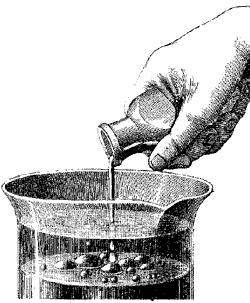BACKGROUND:
 A
solution consists of a solute (the dissolved material) and a solvent (the
substance in which the solute is dissolved). The solute is present in a
smaller quantity than the solvent. As the amount of solute in a solution
increases, the solution becomes more concentrated. At the point of maximum
concentration, the solution is saturated. Any additional solute added to a
saturated solution will precipitate and drop to the bottom of the container.
In general, increasing the temperature of a solution will increase how much
solute can be dissolved in it (solubility). Once solute temperature has been
increased, more solute has been added, but no more will dissolve, the
solution is termed supersaturated. A
solution consists of a solute (the dissolved material) and a solvent (the
substance in which the solute is dissolved). The solute is present in a
smaller quantity than the solvent. As the amount of solute in a solution
increases, the solution becomes more concentrated. At the point of maximum
concentration, the solution is saturated. Any additional solute added to a
saturated solution will precipitate and drop to the bottom of the container.
In general, increasing the temperature of a solution will increase how much
solute can be dissolved in it (solubility). Once solute temperature has been
increased, more solute has been added, but no more will dissolve, the
solution is termed supersaturated.
Supersaturation is important when crystals form. For
example, when making rock candy from sugar you have to boiling the water to
a high temperature so you can dissolve more sugar in the solution. Only then
can you precipitate crystals of sugar on a string.
PROCEDURE:
Exercise 1.
- Instruct the students to fill a 250 ml container
with 200 ml of water. Have them put 4 ml of salt in a filter and fold it
as diagramed on the lab sheet.
- Place the filter on the surface of the water. Have
the students record what they see on their lab sheets. They should see
very thin waves, called schlieren, flowing from the filter into
the water.
- Explain what is happening to the salt. The water
can pass through the filter. It then dissolves the salt crystals into
individual salt molecules, which can move through the holes in the
filter. The salt + water forms a solution.
Exercise 2.
- In this exercise the students will see that more
solute will dissolve when the temperature of the solvent is increased.
Depending on the beakers you are using, you may want to predetermine the
amount of hot and cold water for each trial.
- Have the students measure cold water into a beaker.
Then have them add salt (start with 1 ml increments) and allow it to
dissolve. Have the students record how much salt the solvent will hold
in solution.
- Repeat the experiment, using the same volume of hot
water. Again add salt, and record how much salt can be held in solution.
- Repeat steps 5 and 6, but using sugar instead of
salt. Record the data on the sheet. For both solvents, the cold water
forms a saturated solution, and the hot water forms a supersaturated
solution.
- The students have observed a physical change in
this activity. The properties of the solute are maintained in their
respective solutions. They also observed how solutes (salt and sugar)
are dissolved in different temperatures of water.
|